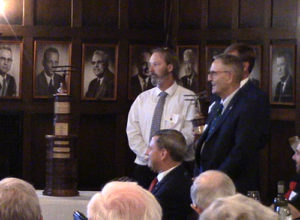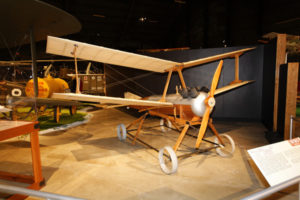The Kettering BUG Award
The Kettering Flying Torpedo (BUG)

2019 BUG Award Winners from Kratos
October 2018 we celebrated the 100th anniversary of the first flight of the Kettering Aerial Torpedo, the BUG. This Year we will celebrate the 104th anniversary of a unique flight test program which came to pass at Carlstrom Field near Arcadia, Florida because of the success of the BUG in Dayton Ohio.
The annual award is prestigious recognition of an individual or organization that has demonstrated outstanding improvement or advancement in UAS technology or systems. It covers a range of excellence in four distinct categories:
- Concept – Innovations that not only address a need, but solve a problem
- Value – A primary driver in Kettering’s innovations
- Delivery – Combining communication, marketing and the mastery of delivery
- Impact – Demonstrating commercial success, but also sustaining sensitivity to broader implications
Recipients are truly at the apex of their industries, and the Engineers Club of Dayton is proud to select the winner from a pool of deserving contestants.
The nominations will be evaluated by volunteer experts and completed August 1, 2022. The formal announcement will be made August 2022. The formal presentation will be made on October 12th at the Engineer’s Club of Dayton. It will be the 104 anniversary of the Kettering Bug first flight.
2019 BUG Award Presentation
Make full screen by clicking icon on the
bottom right after starting the video…
Kettering BUG History
Make full screen by clicking icon on the
bottom right after starting the video…
History of Charles F. Kettering
Make full screen by clicking icon on the
bottom right after starting the video…
Ohio UAS Presentation
Make full screen by clicking icon on the
bottom right after starting the video…
History of The Bug
 During World War I, the United States Army Aircraft Board asked Charles Kettering of Dayton, Ohio to design an unmanned “flying bomb” which could hit a target at a range of 64 kilometers (40 mi). Kettering’s design, formally called the Kettering Aerial Torpedo but later known as the Kettering BUG, was built by the Dayton-Wright Airplane Company. Orville Wright acted as an aeronautical consultant on the project, while Elmer Ambrose Sperry designed the control and guidance system. The first BUG was flown in Dayton Ohio on October 2, 1918.
During World War I, the United States Army Aircraft Board asked Charles Kettering of Dayton, Ohio to design an unmanned “flying bomb” which could hit a target at a range of 64 kilometers (40 mi). Kettering’s design, formally called the Kettering Aerial Torpedo but later known as the Kettering BUG, was built by the Dayton-Wright Airplane Company. Orville Wright acted as an aeronautical consultant on the project, while Elmer Ambrose Sperry designed the control and guidance system. The first BUG was flown in Dayton Ohio on October 2, 1918.
It should be noted that each of the designers made history and changed the way mankind has the ability to travel in the air, on the ground and on water. Mr. Kettering invented the electric starter which allowed people to start an automobile without fear of breaking their arm in the event of a backfire. Orville Wright along with this brother Wilbur invented and flew the first manned aircraft capable of maneuvering. Dr. Elmer Sperry developed the gyro-stabilizer, the heart of the Auto-Pilot which is usable on both aircraft and ships.
The BUG was an experimental, unmanned aerial torpedo, the forerunner of present-day cruise missiles. It was capable of striking ground targets up to 64 kilometers (40 mi) from its launch point, while traveling at speeds of 80 kilometers per hour (50 mph). It was powered by a 4-cylinder, 40-horsepower De Palma engine. The engine was produced by the Ford Motor Company and cost about $40 each. The fuselage was constructed of wood laminates and paper-mâché, while the wings were made of cardboard. The BUG met all the requirements. The cost of each Bug was $400.
The BUG was launched using a dolly-and-track system, similar to the method used by the Wright Brothers when they made their first powered flights in 1903. Once launched, the small on-board gyroscope guided the aircraft to its destination. The control system used a pneumatic/vacuum system, an electric system and an aneroid arometer/altimeter.
To ensure the BUG hit its target, a mechanical system was devised that would track the aircraft’s distance flown. Before takeoff, technicians determined the distance to be flown relative to the wind, taking into account wind speed and direction along the flight path. This was used to calculate the total number of engine revolutions needed for the BUG to reach its destination. When the total revolution counter reached this value a cam dropped down which shut off the engine and retracted the bolts attaching the wings, which fell off. The Bug began a ballistic trajectory into the target; the impact detonated the payload of 82 kilograms (180 lb.) of explosives.
The prototype BUG was completed and delivered to the Aviation Section of the U. S. Army in 1918, near the end of World War I. The first flight on October 2, 1918 resulted in a crash in that the plane climbed too steeply after takeoff, stalled and hit the ground. Subsequent flights were successful, and the aircraft was demonstrated to Army personnel at Dayton where it met all the requirements.
In 1919 the Army wanted to do additional testing and shipped several BUGs to Carlstrom Field, a WW I military training airfield, located southeast of Arcadia, Florida. While there the BUG was successful on six flights. On one of the flights, the BUG climbed out of sight and Mr. Kettering said ”Leave the thing up there!” But his crew went out to find it and they did, 21 miles away. Carlstrom Field remained open until 1922.
Despite some successes during initial testing, the BUG was never used in combat. Officials worried about their reliability when carrying explosives over Allied troops. By the time the War ended about 45 BUGs had been produced. The aircraft and its technology remained a secret until World War II.
During the 1920s, what had become the U.S. Army Air Service continued to experiment with the BUG until funding was withdrawn. From April 1917 to March 1920 the US Government spent about $275,000 on the Kettering Bug.
At the same time as the BUG was being produced and flown, Messrs. Kettering and Wright along with Colonel Edward Deeds, President of National Cash Register founded the Engineers Club of Dayton and built its building in 1918. To celebrate the100th anniversary of these two events, first flight and Club’s building completed, the Engineers Club of Dayton established the Charles F. Kettering Aerial Torpedo BUG Award.
The Engineers Club of Dayton along with Sinclair College National UAS Training and Certification Center and Dayton Development Coalition are issuing a call for nominations for the second Charles F Kettering Aerial Torpedo BUG Award. Nominations can be submitted beginning April 30, 2020 and will close on July 3, 2020.
The nominations will be evaluated by volunteer experts and completed August 1, 2022. The formal announcement will be made August 2022. The formal presentation will be made on October 12th at the Engineer’s Club of Dayton. It will be the 104 anniversary of the Kettering Bug first flight.
The point of contact at the Engineers Club of Dayton is Mr. Ted Fecke
ted@treble-one.com or U.S. Postal Service:
Engineers Club of Dayton 110 East Monument Ave., Dayton Ohio 45402
